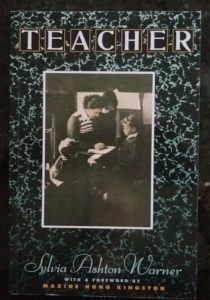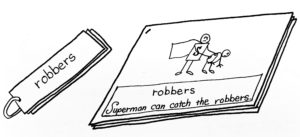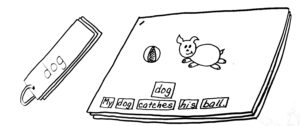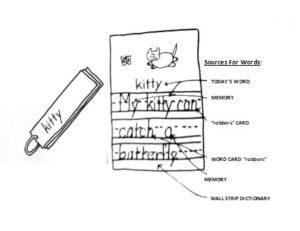The “natural approach,” described in this website, Kids Write to Read, has at its heart two basic strategies, Key Words and The Steps. I developing the approach, I was primarily influenced by the work of Maria Montessori and Sylvia Ashton-Warner. I also brought with me the insight I’d gained by watching how my own two preschoolers grew in their understanding of communication through print. With all this in mind, I worked out the specific strategies I’m describing here by responding to the needs of the children in my K-2 classroom, in a rural area of southern California. Half of them were the children of migrant farm workers, half the children of the land owners and professionals who had chosen to live in the country.
From montessori: following the child’s natural development & managing an active classroom
 As a young mother, I became so inspired by Montessori’s books describing her theory and practice, that I established a Montessori school for my own two preschool daughters. (Pictured here are my well-worn copies of what I found to be her two most valuable books.) Our Montessori Directress was a Dutch woman, educated in Holland. I didn’t work in our classroom, but frequently observed the class in action, where I gained two important insights I carried with me into my K-2 classroom years later:
As a young mother, I became so inspired by Montessori’s books describing her theory and practice, that I established a Montessori school for my own two preschool daughters. (Pictured here are my well-worn copies of what I found to be her two most valuable books.) Our Montessori Directress was a Dutch woman, educated in Holland. I didn’t work in our classroom, but frequently observed the class in action, where I gained two important insights I carried with me into my K-2 classroom years later:
1) Children are willing and able to carry out more complex tasks independently and with greater care and precision than many of us realize — if, that is, they are carefully shown how to handle a variety of materials and equipment, then allowed to choose which to work with. See more about the Montessori approach here.
2) The impulse to write often occurs naturally at around age 4, when in a Montessori classroom, a child who shows interest will be shown how to manipulate a “movable alphabet” to make rhyming words. I take a different approach to developing literacy skills, as you will see by my use of what I’ve come to call Key Words. It’s based on the concept of Key Vocabulary, which was published by Sylvia Ashton-Warner in the 1960’s.
Unfortunately, that was after Montessori died. But I wish she had seen the idea, for I believe it to be very much in line with her thinking. In using Key Words, I have found that children are interested in and capable of recognizing their Key Word the following day after we write it for them — and thereafter. Even a child as young as three years old can gather a collection of Key Words they recognize immediately. And even more telling, they love getting a new one each day and playing with them. I’ve also found they begin to write their own thoughts at around four years old. They simply absorb the process by our letting them see what we’re doing as we write the sentence they dictate about their Key Word. See my latest and what I hope to be my clearest discussion about using Key Words here.
from ashton-warner: Key vocabulary
 A few years after my Montessori experience and while working toward my California elementary teaching credential, I happened onto the book, Teacher, by Sylvia Ashton-Warner. This was an account of her years teaching the children of the Maori tribes, at the primary level in New Zealand. There she found the basal readers supplied by the British were of virtually no use: The version of English and the lives of the children depicted in those books were just too far removed from what her students were experiencing at home.
A few years after my Montessori experience and while working toward my California elementary teaching credential, I happened onto the book, Teacher, by Sylvia Ashton-Warner. This was an account of her years teaching the children of the Maori tribes, at the primary level in New Zealand. There she found the basal readers supplied by the British were of virtually no use: The version of English and the lives of the children depicted in those books were just too far removed from what her students were experiencing at home.
So she began having them first talk each day about things that perhaps worried, delighted or frightened them — then tell her what word to write that represented what they had been saying. These “captions for their mind pictures” then became the basis for their reading and writing for that day and beyond. She eventually called these special words their “Key Vocabulary.” Because they came from their own vivid experiences and strong feelings, they “stuck,” so that day after day they remembered and could “read,” or more accurately, recognize them.
from my own two preschoolers: hints of a child’s natural path toward literacy
This phenomenon of non-readers remembering their own special words intrigued me, as I had already seen how easily my own preschoolers had made the connection between talking and printing — apparently just from seeing me write grocery lists, letters to their grandparents, and notes to myself at home. For instance, without my saying anything about my own writing, they had nevertheless noticed what I was doing and began to scribble on their own drawings, claiming they had written words. They would bring a drawing to me and say something like, “See, I made this picture of a dog, and here’s where it says, ‘dog.'” From this, I realized that all on their own, they had come to understand that writing was “talk written down.” And they wanted to do it themselves.
I also noticed that the way they had developed this understanding of print was similar to the way they had learned to speak: They had apparently effortlessly absorbed the skills involved in speaking, simply by having someone older model it for them, in context. And importantly, there was no drill of the skills involved with speech. Modeling simply took place where the purpose was to impart meaning: No one sat them in a highchair each morning, showed them a bottle of milk and had them repeat “milk” until they made the connection and could automatically repeat it on the next occasion a bottle of milk appeared. They absorbed the connection through modeling, in context, with meaning.
So I thought the connection between speech and print might be accomplished in the same effortless way, if I could just figure out how to immerse young children in the writing process where the purpose was to communicate their ideas. After that, all that would be needed was a way to support them as they slowly took over the process on their own. So I began to experiment with Key Vocabulary during my semester of practice teaching.
developing the steps in my K- 2 classroom
Once armed with my elementary credential, I began teaching in a one-school district in a rural area near Los Angeles. Almost half of that school’s students were the children of migrant farm workers, while the parents of the others owned the agricultural land or were professionals who chose to live in the country.
Both non-English and some native-English speakers in the school’s primary grades had been struggling with traditional approaches to reading. So during my job interview, I explained my idea to use Key Vocabulary as the centerpiece of a comprehensive literacy program. This was welcomed as a possibility, I was hired and allowed to experiment.
I began my first full year there with a K-2 class of 28 students who had incoming reading levels ranging from zero to 8th grade. Almost half of the children had virtually no experience with print at home, as their parents were illiterate. So I set out to develop an individualized language experience program based on Key Vocabulary — within an active classroom setting designed to allow each child to work at their own pace.
I began by gradually establishing what became our 75 minute Writing Work Period, focused on literacy skills. During this time, each child would ask for one special word and work independently on a follow-up activity with that word.
Their word was written on card stock and placed on a metal word ring, remaining there if the child recognized it the following day. (Eventually every child had a sizable collection of words they knew.) A duplicate of that day’s word was made for them on newsprint, and their follow-up activity was to glue the duplicate into their writing book and draw a picture about it. When finished, they would show me their work, then go on to select one of the activities always available in the room: self-teaching activities, games, and/or interest areas I had introduced to the entire class ahead of time, using what I knew of a Montessori Silent Demonstration.
We had extra help during this work period: The district provided one bilingual aide who stayed with us for the entire morning. In addition, the federally funded, Migrant Education Program, provided a bilingual aide for an hour during the writing period. Beyond that, I recruited parent volunteers and cross-age tutors to help take the children’s dictation.
Using Key Vocabulary went very well. (We called it “Key Words” by then.) The children liked talking with someone older to get their word, and they quickly became accustomed to their routine: ask for a word, glue the duplicate, make a drawing, have work checked, replace the writing book on the shelf — then choose another activity.
 Once they had the routine down, I had them dictate a sentence to go with each day’s new word and “read” the sentence back immediately after it was written for them. At first it was obvious they were just remembering something they had just said. So I didn’t ask them to try to read it after that one time. But then once the were able to point to each word as they read their sentence back, plus point to a word when asked out of order, I increased the challenge by having them cut the duplicate up, reassemble the sentence, and glue it into their book.
Once they had the routine down, I had them dictate a sentence to go with each day’s new word and “read” the sentence back immediately after it was written for them. At first it was obvious they were just remembering something they had just said. So I didn’t ask them to try to read it after that one time. But then once the were able to point to each word as they read their sentence back, plus point to a word when asked out of order, I increased the challenge by having them cut the duplicate up, reassemble the sentence, and glue it into their book.
Each time a  child’s skills grew beyond what they had been doing, I experimented with something a little more challenging — to stay just one comfortable step ahead of them. As the year went on in this way, I began to see the children were going through similar stages as they progressed, so that eventually, a series of 6 increasingly complex follow-up activities for Key Words had emerged from the work the children and I were doing together. These are “The Steps” I’m sharing here.
child’s skills grew beyond what they had been doing, I experimented with something a little more challenging — to stay just one comfortable step ahead of them. As the year went on in this way, I began to see the children were going through similar stages as they progressed, so that eventually, a series of 6 increasingly complex follow-up activities for Key Words had emerged from the work the children and I were doing together. These are “The Steps” I’m sharing here.
 Developing an individualized program in the detail I’m describing here, including all the routines and procedures for managing the active classroom, took at least two years, some sleepless nights, and occasional bouts of panic. Apart from The Steps, the most challenging part was to figure out how to keep track of each of them, while giving them the freedom to work independently and grow at a pace that matched their individual development.
Developing an individualized program in the detail I’m describing here, including all the routines and procedures for managing the active classroom, took at least two years, some sleepless nights, and occasional bouts of panic. Apart from The Steps, the most challenging part was to figure out how to keep track of each of them, while giving them the freedom to work independently and grow at a pace that matched their individual development.
Eventually, I realized my role was something like that of a doctor who diagnoses, prescribes, and frequently checks for progress — then has physical therapists and nurses (my aides and volunteers) to carry out prescriptions between checkups. To facilitate this, I devised a variety of routines and procedures I came to think of as a system of “remote control” over the entire process — described here in the pages devoted to managing this approach in a classroom.
the need for encouragement and support
Working out the comprehensive approach I ultimately called Key Words and The Steps — which includes the strategies for developing literacy skills in an individualized, active classroom — was definitely a process of trial and error. and I had challenges from those who thought I should just be using a basal reading program, as most others were doing. But I kept at it, gaining courage and determination though contacts I made by attending the annual Claremont Reading Conference, where educators from around the country (and beyond) who believed in the value of the language experience approach, came each year to share ideas and give one another moral support. There I gained encouragement, guidance, and support from the nationally know and respected Dr. Jeannete Veatch, who encouraged me to leave the classroom and begin showing other teachers what I was doing. (See images of her many books here.)
I could also rely on two women closer to home: Dorothy, a consultant with the Ventura County Dept. of Education who vouched for the legitimacy of what I was trying to do; and Janet, one of the other primary teachers in my school, who understood it and became not only a friend, but an ally when I needed one. Then before long, I also began to have the support of parents who asked to have their children assigned to my classroom. (One year, by parent request, I had two brothers — one K and the other in 2nd grade — which worked out just fine.)
Knowing how important encouragement and support was to me during that time is what’s prompted me to establish this website. I’m hoping to provide that vital ingredient here for those teachers I know must be out there, feeling much as I did while working things out.
So first, I want to welcome all interested in gaining and sharing ideas here. And I want to emphasize that the strategies I’m sharing are just one way to structure an individualized language experience approach — this “mirroring of the way we learn to speak.” In visiting many classrooms over the years — as a consultant, a researcher, or simply to observe — I’ve seen some very creative teachers. All pick and choose ideas from others and/or invent strategies of their own. So I expect that while some who are interested in this basic approach may want to adopt all of what I’ve done as described here, others will adapt it in various ways or take just a few ideas that help them move farther in the direction they’re already going. For still others, this website will simply be confirmation of a program they have already fully established on their own.
next —>Why and How “A Natural Approach” Works
<— back Brief Overview Of What A Child Is Doing
individualized language experience